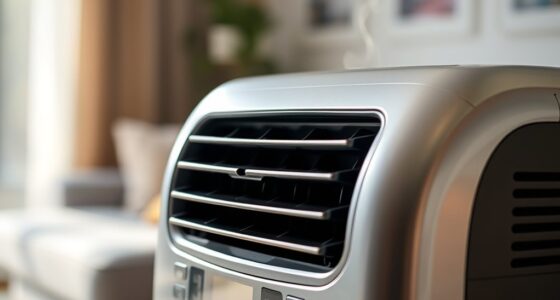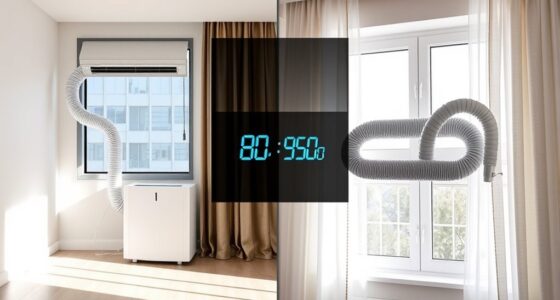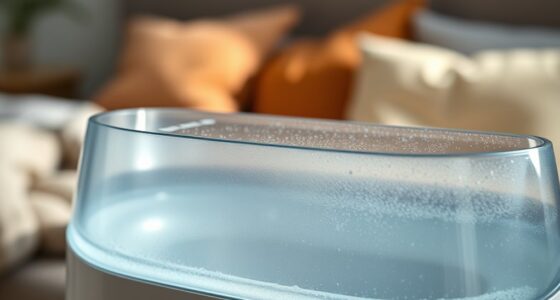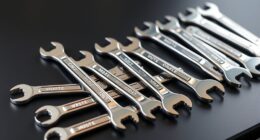To quickly improve indoor air quality during wildfire smoke, choose an air purifier with a high-efficiency HEPA filter that operates quietly. Place it centrally, away from walls, windows, and pollution sources, to maximize coverage. Seal gaps around doors and windows to prevent outdoor smoke infiltration, and remove clutter for better airflow. Regularly maintain filters and adjust settings based on air quality. For more effective tips and strategies, continue exploring ways to keep your indoor air safe.
Key Takeaways
- Use a high-efficiency HEPA air purifier with adjustable fan speeds for quick smoke removal.
- Place the purifier centrally, away from walls and pollution sources, to maximize coverage.
- Seal gaps around windows and doors to prevent outdoor smoke from entering indoor spaces.
- Run the purifier continuously at high speed during smoky conditions, then lower speeds afterward.
- Combine with ventilation during low pollution periods and eliminate indoor sources to enhance air quality.
Choosing the Right Air Purifier for Smoke Removal
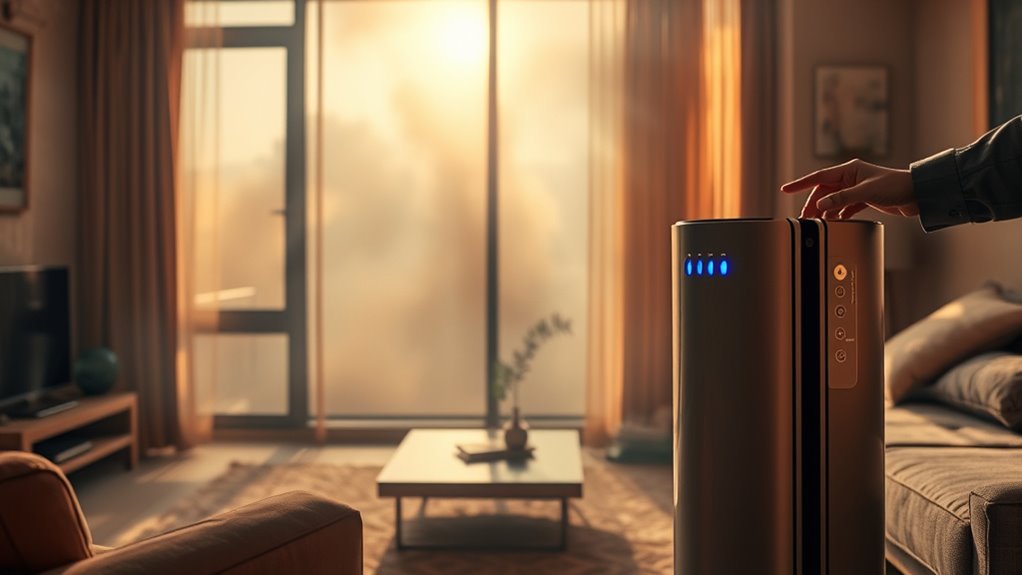
When selecting an air purifier for smoke removal, it’s important to choose a device equipped with a high-efficiency filter designed to capture tiny particles. HEPA filters are essential because they trap smoke particles as small as 0.3 microns, ensuring cleaner indoor air. Pay attention to noise levels, especially if you plan to run the purifier continuously or during sleep. Look for models labeled as quiet or with adjustable fan speeds to minimize disruption. A purifier with a HEPA filter not only effectively removes smoke but also reduces airborne allergens and pollutants. Keep in mind that a quiet device enhances comfort and encourages consistent use. Additionally, selecting a model with advanced filtration technology can further improve smoke removal efficiency, providing a healthier indoor environment. Choosing the right combination of powerful filtration and low noise makes your smoke mitigation efforts more effective and less intrusive.
Optimal Placement of Your Air Purifier

The effectiveness of your air purifier depends heavily on where you place it within your space. Proper placement ensures peak air flow and maximizes its ability to clean the air effectively. To achieve this, consider these key points:
- Place the purifier in a central location to cover the entire room size efficiently.
- Keep it off walls and furniture to avoid obstructing airflow.
- Position it away from sources of pollution, like windows or vents, to prevent contamination.
- For optimal performance, ensure the air purifier is positioned away from sources of pollution to maintain clean air circulation throughout the room.
Preparing Your Indoor Space for Maximum Effectiveness
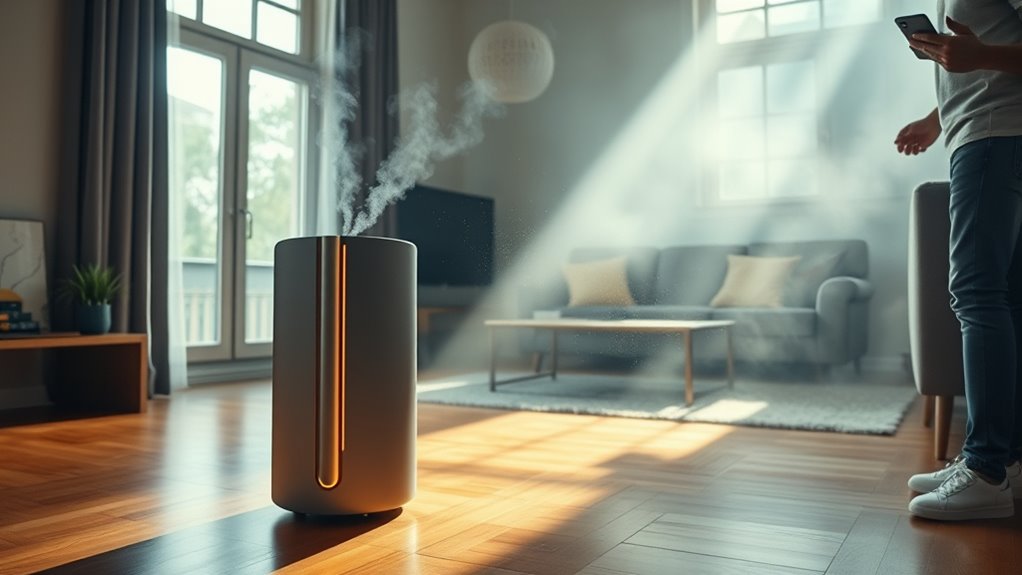
To guarantee your air purifier works at its best, you need to prepare your indoor space by minimizing sources of airborne pollutants and optimizing airflow. Start by removing clutter and reducing indoor activities that generate dust or fumes. Seal gaps around windows and doors to prevent outdoor smoke from infiltrating and compromising indoor air quality. Improving airflow ensures the purifier circulates air effectively, reaching all corners. Use the table below to understand how different adjustments impact respiratory health and indoor air quality:
| Adjustment | Effect on Respiratory Health & Indoor Air Quality |
|---|---|
| Minimize pollutant sources | Reduces airborne contaminants, improving air quality |
| Seal gaps and leaks | Limits outdoor smoke infiltration, protecting respiratory health |
| Optimize airflow | Ensures even purification, enhancing indoor air quality |
Quick Tips for Operating and Maintaining Your Purifier
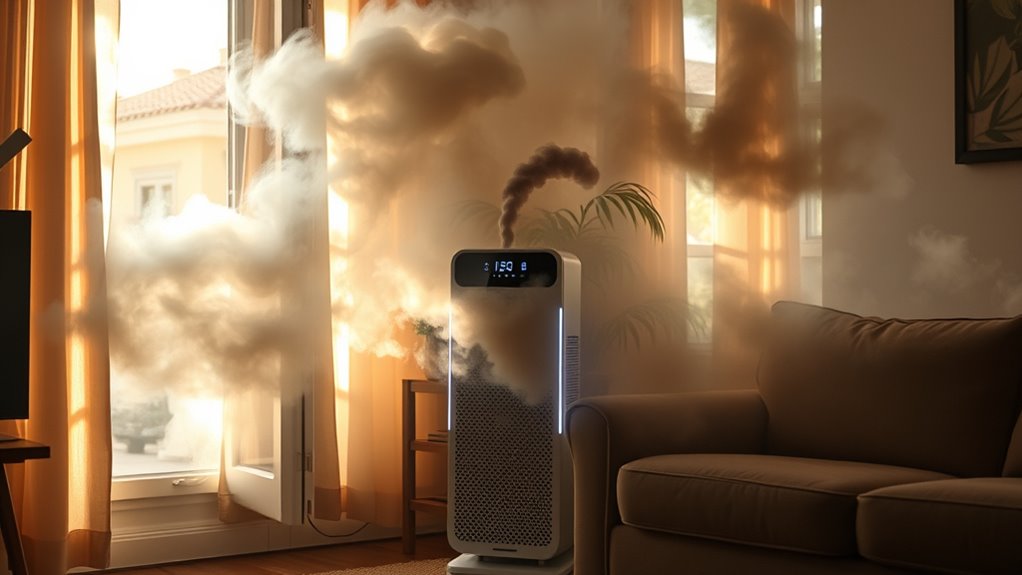
Regularly operating and maintaining your air purifier is key to keeping indoor air clean. To do this effectively, be sure to check the filter regularly and replace it as needed—clogged filters reduce efficiency and air quality. Adjust the fan speed based on air quality; higher speeds clean the air faster during smoky conditions, while lower speeds save energy once the air improves. Keep these tips in mind:
Regularly check filters and adjust fan speed for optimal air purifier performance.
- Monitor the filter and replace it promptly for ideal performance
- Use higher fan speeds during heavy smoke and lower speeds afterward
- Clean the exterior and vents to prevent dust buildup, ensuring smooth operation
- Consider the filter replacement indicators provided by your device to maintain optimal performance
Additional Strategies to Reduce Indoor Smoke Levels

Implementing effective ventilation is one of the best ways to reduce indoor smoke levels. Open windows during low pollution times, and use exhaust fans to vent indoor air outside. Incorporate indoor plant air purifiers like snake plants or spider plants; they can help absorb some airborne toxins. For DIY smoke filtration, create simple setups using activated charcoal or HEPA filters in portable fans. To compare options, see the table below:
| Method | Effectiveness | Cost |
|---|---|---|
| Indoor plant air purifiers | Moderate removal | Low |
| DIY smoke filtration | Variable, depends on setup | Low to Moderate |
| Ventilation | Immediate reduction | Free |
| Air purifier filters | High, targeted removal | Moderate to high |
| Sealing leaks | Reduces smoke entry | Low |
Combine these strategies for ideal indoor air quality during wildfires.
Frequently Asked Questions
How Often Should I Replace the Air Purifier Filters During Wildfire Season?
You should replace your air purifier filters every 1 to 3 months during wildfire season, depending on filter maintenance and air quality. Check your device’s manual for specific replacement frequency recommendations. If you notice reduced airflow or odors lingering, it’s time for a filter change. Regular replacement guarantees peak performance and cleaner air, especially when wildfire smoke is present. Don’t delay filter maintenance to keep your indoor air safe and healthy.
Can Air Purifiers Completely Eliminate All Indoor Wildfire Smoke?
While air purifiers substantially improve indoor air quality, they can’t completely eliminate all wildfire smoke. To maintain ideal performance, you need to follow proper air purifier maintenance and replace filters as recommended, especially during wildfire season. Keep in mind that filter lifespan varies, and even with diligent care, some fine particles may still linger. Using multiple purifiers and ensuring proper ventilation can further reduce indoor smoke levels effectively.
Are There Specific Features to Look for in an Air Purifier for Wildfire Smoke?
When choosing an air purifier for wildfire smoke, look for models with HEPA filters and activated carbon. HEPA filters effectively trap tiny smoke particles, guaranteeing cleaner air, while activated carbon absorbs odors and harmful gases. Make certain the purifier covers your room size and runs continuously during smoky conditions. These features work together to substantially reduce indoor smoke, making your home safer and more comfortable during wildfire events.
How Long Does It Typically Take to Notice Improvements in Indoor Air Quality?
Imagine watching a fog lift as your air purifier runs. Typically, you’ll notice improvements in indoor air quality within a few hours, especially if you monitor air quality metrics. You’ll see clearer air and less smoke smell. Keep an eye on filter lifespan, as it influences effectiveness. After about 24-48 hours, your space should feel fresher, cleaner, and healthier, thanks to your quick setup and efficient purifier.
Do Air Purifiers Work Effectively in Large Open-Concept Spaces?
Yes, air purifiers can work effectively in large open-concept spaces if you optimize airflow and maintain filters regularly. To maximize efficiency, position purifiers centrally and ensure unobstructed airflow. Keep filters clean and replace them as recommended by the manufacturer. This guarantees continuous purification, helping clear wildfire smoke and improve indoor air quality quickly. Proper airflow and filter maintenance are key to achieving the best results in large areas.
Conclusion
Now that you know how to set up your air purifier quickly and effectively, you’ll breathe easier even during wildfire smoke events. Remember, choosing the right purifier and placing it wisely makes all the difference. Keep it running, maintain it regularly, and combine it with other strategies for the best results. Isn’t it reassuring to think you can protect your home and loved ones from harmful smoke with just a few simple steps?


